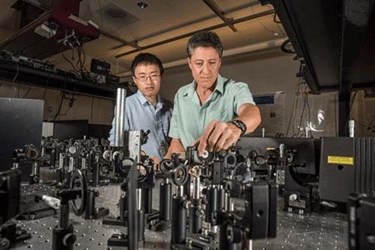Sandia Researchers Build First Terahertz-Speed Polarization Optical Switch
By Jof Enriquez,
Follow me on Twitter @jofenriq

Scientists at Sandia National Laboratories, along with colleagues from North Carolina State University, have built the first all-optical device capable of switching light at terahertz speeds. Ultrafast optical processing in a device that is smaller than anything like it before, and at a rate that is much faster than what traditional electronics could perform, could find myriad applications in imaging, chemistry, and biology.
Researchers for years have tried to surmount the inherent limitations of conventional electronics — such as slow charging rate and poor heat dissipation — and instead use photons to perform high contrast all-optical switching in a very thin device. Their efforts, however, have been stymied by the use of polarizers and waveplates that were either static, or can achieve only gigahertz switching speeds in relatively big devices.
Now, a team at Sandia has shown that it is possible to build a smaller device wherein light intensity or polarization can successfully be switched optically, or go from completely dark to completely transparent, at ultra-fast terahertz speed rates.
“Instead of switching a current on and off, the goal would be to switch light on and off at rates much faster than what is achievable today,” said Yuanmu Yang, a former Sandia Labs postdoctoral employee who worked at Sandia's Center for Integrated Nanotechnologies, where the device was built.
The material was key to achieving the desired effect, since conventional plasmonic materials like gold or silver barely change properties when fired at by an optical control beam.
The switching device features a unique gateway plasmonic cavity with a high-mobility indium-doped cadmium oxide (CdO), a material sourced from North Carolina State University. A laser beam switches the device on and off by heating up electrons in the doped CdO, which drastically modifies the opto-electrical properties of the plasmonic cavity. The material also relaxes at terahertz speeds, in a few hundred femtoseconds, or in less than one trillionth of a second.
“So we can switch this material on and off at a rate of a few trillion times per second,” said Yang.
With a compact all-optical device capable of performing terahertz switching, scientists can more accurately study the structure and dynamics of matter which usually shift at a rate of a few terahertz.
“Having this tool lets us study the dynamics of physical processes like molecular rotation and magnetic spin. It’s important for research and for moving knowledge further along,” said Yang.
Sandia's device can also act as a rapid polarization switch that alters the characteristics of light, something that is useful in computing, telecommunications, signal processing, image processing, laser-based imaging, and in chemistry and biology experiments, where precise measurements are critical.
Details of this research work can be found in an article published in Nature Photonics.
